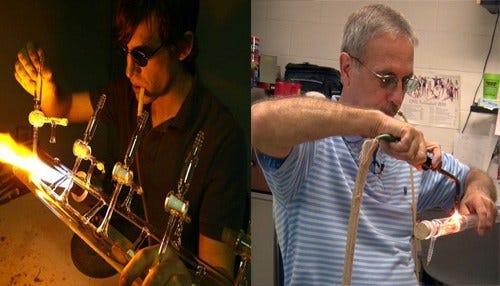Glassblowers Bring New Breath to Scientific Research
 Ford (left) and Garvin (right) custom-make laboratory glassware.
Ford (left) and Garvin (right) custom-make laboratory glassware.
Subscriber Benefit
As a subscriber you can listen to articles at work, in the car, or while you work out. Subscribe NowThey work by the light of a flame, luring a material—not quite solid, not quite liquid—to bend to breath, heat and researchers’ demands. Indiana has only a few scientific glassblowers in the entire state, working in university laboratories where they strive to shatter the glass ceiling of what’s possible in research. These somewhat mysterious, unsung heroes of the laboratory—scientists in their own right—scoff at traditional test tubes and beakers, blowing custom-made glassware that will blow your mind.
University of Notre Dame Glass Shop Manager Kiva Ford recently sealed together two pieces of hollow glass tubing—“a pretty normal thing,” he explains—except one of the tubes was the diameter of half a human hair.
“Basically every week, someone asks me to do something that’s maybe impossible—that I don’t know if I can do,” says Ford. “And I work with really bright researchers here; a lot of times they try to do things themselves, so if they come to me with a problem, it’s usually something that might be impossible. Sometimes I don’t know if it’s going to work, but you just try.”
And he thrives on the trying. When Notre Dame chemists, scientists and engineers encounter roadblocks in their research because existing lab glassware doesn’t suit their needs, they rely on Ford to shape something that doesn’t exist until he forms it in the flame.
It’s the same story on Indiana University’s Bloomington campus, where Director of Glassblowing Services Don Garvin flourishes in the fragility of it all.
“The most challenging thing is knowing how much to heat the glass and how much to let the glass cool,” says Garvin. “If you heat it too fast, it’ll crack, if you cool it too fast, it’ll crack. It’s kind of like a surfer trying to stay on the crest of a wave; you’re always trying to find that optimum temperature.”
Both tradesmen are members of the American Scientific Glassblowers Society; the group hit its highest membership numbers in the 1960s and 1970s, fueled by the science of putting a man on the moon. Now with just 520 members nationwide, the society reflects the rarity of Garvin and Ford’s talents. The process of crafting their delicate creations involves finding the elusive balance between glass’ physical characteristics and researchers’ grand visions.
“There’s all these variables you have to think about; what’s the temperature range for this experiment, is the glass going to have water in it, is it going to have electricity involved?” says Garvin. “You have to put your heads together, come up with a design, and then we try to go from a drawing to a useful tool they can use in research.”
Both glassblowers have had successes both unique and noteworthy. Garvin has worked with a surgeon at Riley Hospital for Children at IU Health to develop a heart pump. Garvin’s scientific skills even crossed over to artistic, when a visiting composer for the movie “The Last of the Mohicans” arrived on campus to perform a concert with his glass flute—only to discover it had been shattered beyond repair during the flight. “That was on a Monday,” says Garvin, “and Wednesday morning, he walked out of here with a new flute.”
Ford’s creations are being used in Switzerland as part of The Higgs boson project, an internationally-renowned game-changer in the field of particle physics. He sealed his commitment to scientific glassblowing early in his career while working at a large pharmaceutical company; his creations helped build a reactor that enabled a cancer drug to be manufactured ten times faster.
“[The developers] called me in congratulating me, saying this [drug] is going to help people who have no hope,” says Ford. “After something like that, you really understand how many people you can actually help. You’re kind of in the background of all this scientific research, and you don’t get that much recognition, but after that, it really struck me the type of impact I could have.”
With just a few scientific glassblowers in the state, Garvin jokes it gives him job security. Ford notes that the need for glass in laboratories is decreasing as technology changes and advancements are made in plastics—“and you can drop plastic, and it’ll bounce, it won’t break.” But both contend glass will always play a vital role in research.
“If you look at all the great discoveries of mankind over the past couple hundred years, a lot of them involve glass: the lightbulb, the telescope, fiber optics, silicon wafers,” says Ford. “So many of those industries involved glass, and a lot of them couldn’t have happened without the assistance of a scientific glassblower, or at least someone educated in glass.”
Inarguably, Ford and Garvin’s unique skills are quietly shaping lab experiments by harnessing heat, wielding a steady hand and blowing new breath into scientific research.
Ford says, ironically, a huge success in his line of work sometimes “looks like nothing.”
Ford says his glassware is being used in projects ranging from water to solar.
Garvin says he enjoys working with the scientists behind the experiments.
Garvin says some glassware requires more time than others.

